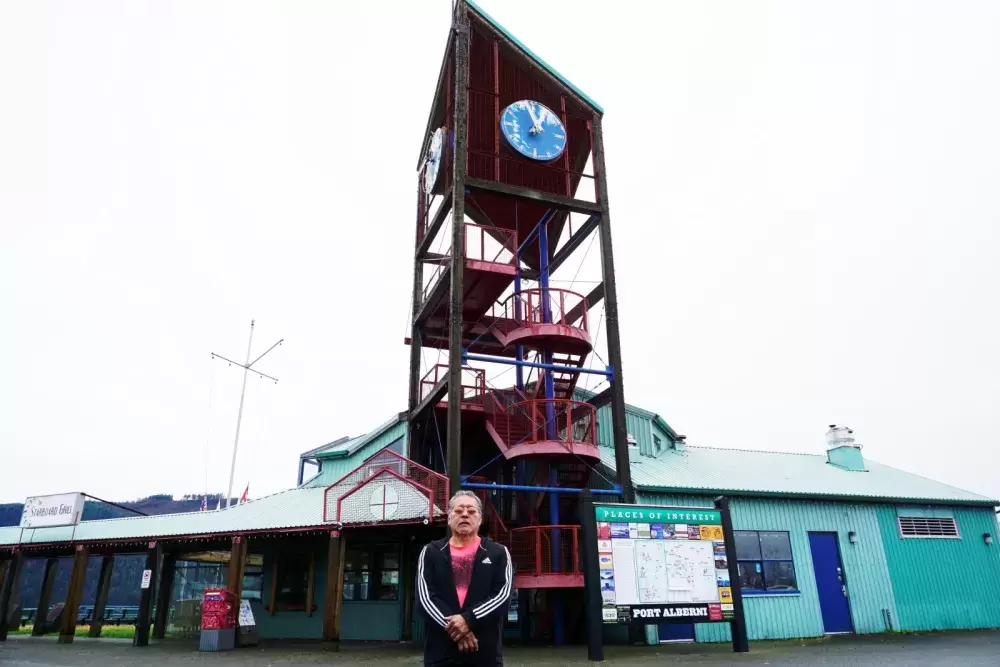The Harbour Quay Clock Tower, built in the 1980s, has gotten a facelift and is about to be unveiled at National Indigenous Day celebrations, hosted jointly by Tseshaht First Nation and the City of Port Alberni.
The Clock Tower has been under wraps for months as it goes through its transformation to the Wolf Tower, or ƛuukʷatquuʔis, which means Wolf Ritual Beach in the Tseshaht language.
Port Alberni City Council and the Tseshaht First Nation leadership have been collaborating on the transformation of the clock tower.
“When we were first elected we said we can’t have reconciliation without talking about land and territories,” said Ken Watts, Tseshaht’s elected chief.
He praised Port Alberni’s city council, led by Mayor Shari Minions, for putting action to their words.
“They got the funding in place and partnered with us,” said Watts.
“Walking together is an expression of meaningful action and ongoing commitment to reconciliation efforts. We look forward to celebrating Indigenous culture and all cultures that make up Port Alberni and surrounding areas,” reads a City of Port Alberni invitation to the June 21 event.
The city says they will, in partnership with Tseshaht First Nation, celebrate the re-awakening of ƛuukʷatquuʔis with the unveiling of the Wolf Tower.
Tseshaht beachkeepers have been traveling to each Nuu-chah-nulth nation over the past several days, inviting hereditary leaders to paddle to the shores of Harbour Quay. They will spend the day celebrating a significant cultural event, the recognition of the sacred site that the Tseshaht used for their winter wolf rituals. It was also the winter home of the Tseshaht.
“For more than 100 years the Tseshaht people have been kept from performing our Wolf Ritual at our Winter Village site ƛuukʷatquuʔis that was lost under duress without treaty for settler occupation,” the Tseshaht people stated in their invitation.
They went on to say that ƛuukʷatquuʔis remains a sacred part of their Aboriginal title territories.
Hundreds of guests are expected to attend the day-long event.
“During our dawn-until-dusk celebration, we expect to welcome upwards of 1,000 people,” reads the invitation.
Ha’wiih from neighboring nations were invited to arrive at the ceremony via chaputs (dugout canoe), where they will be welcomed ashore by Tseshaht beach keepers.
“Together we uphold Tseshaht responsibilities and protocols by challenging our neighbouring Nations and other dignitaries to paddle their chiefs to the ceremonial grounds from their own territory or launch from Clutesi Haven Marina and be escorted by our Beach Keepers vessel for a traditional welcoming protocol of coming ashore,” the Tseshaht added.
The event will be open to all people.
“Ed (Tseshaht Councilor, Ed Ross) says it is important to share with other cultures,” said Watts.
There will be a new installation made by Tseshaht artist Willard Gallic Jr. unveiled that day. Tseshaht people will celebrate with their songs and dances before allowing their invited guests to perform.
Guests will be treated to breakfast, lunch, and snacks throughout the day, followed by a traditional feast of salmon and seafood for dinner.
There will be crafters, artisans and Indigenous-focused small businesses to sell their wares. Tseshaht will be performing many of our songs and dances and invite other Nations and cultures to take the floor and share theirs as well.
It has been decades, if not more than a century, that a cultural event of this magnitude has been held at a site that is sacred to the Tseshaht.
“Our people singing and dancing there is really exciting,” said Watts.


